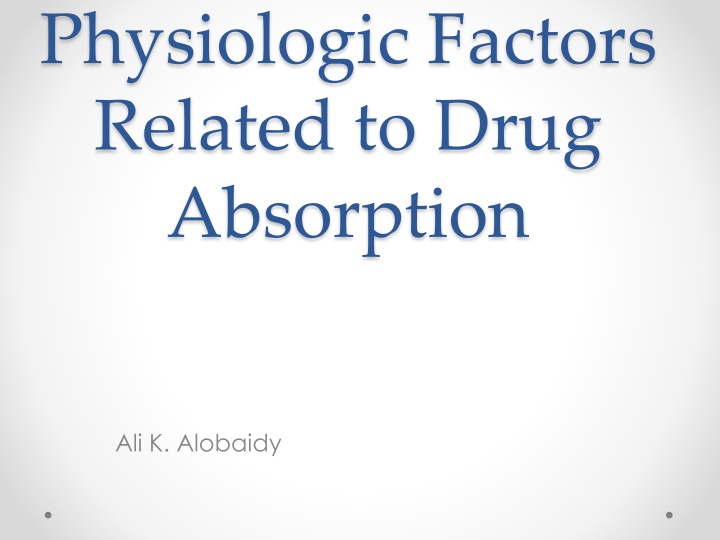
Understanding Physiologic Factors in Drug Absorption
Explore the interplay of physicochemical properties, drug product nature, and anatomy in drug absorption. Learn about various routes of drug administration and the impact of cell membranes on systemic drug delivery.
Download Presentation

Please find below an Image/Link to download the presentation.
The content on the website is provided AS IS for your information and personal use only. It may not be sold, licensed, or shared on other websites without obtaining consent from the author. If you encounter any issues during the download, it is possible that the publisher has removed the file from their server.
You are allowed to download the files provided on this website for personal or commercial use, subject to the condition that they are used lawfully. All files are the property of their respective owners.
The content on the website is provided AS IS for your information and personal use only. It may not be sold, licensed, or shared on other websites without obtaining consent from the author.
E N D
Presentation Transcript
Physiologic Factors Related to Drug Absorption Ali K. Alobaidy
Reference text Shargel L., Yu AB Applied Biopharmaceutics and Pharmacokinetics
Introduction The systemic absorption of a drug is dependent on (1) the physicochemical properties of the drug. (2) the nature of the drug product. (3) the anatomy and physiology of the drug absorption site. All of these considerations are important in the manufacture and biopharmaceutic evaluation of drug products.
Route of Drug Administration Drugs may be given by parenteral, enteral, inhalation, transdermal (percutaneous), or intranasal route for systemic absorption. Each route of drug advantages and disadvantages. The systemic availability and onset of drug action are affected by 1-blood flow to the administration site. 2- the physicochemical characteristics of the drug and the drug product. 3-by any pathophysiologic condition at the absorption site. administration has certain
Many drugs are not administered orally because of drug instability in the gastrointestinal degradation by the digestive enzymes in the intestine. Drug absorption after subcutaneous injection is slower than intravenous injection. Pathophysiologic conditions such as burns will increase the permeability of drugs across the skin compared with normal intact skin. When a drug is administered by an extravascular route of administration (eg, oral, topical, intranasal, inhalation, rectal), the drug must first be absorbed into the systemic circulation and then diffuse or be transported to the site of action before eliciting biological and therapeutic activity. The general principles and kinetics of absorption from these extravascular sites follow the same principles as oral dosing, although the physiology of the site of administration differs. tract or drug
Nature of Cell Membranes Many drugs administered by extravascular routes are intended for local effect. Other drugs are designed to be absorbed from the site of administration into the systemic circulation. For systemic drug absorption, the drug must cross cellular membranes. After oral administration, drug molecules must cross the intestinal epithelium by going either through or between the epithelial cells to reach the systemic circulation. The permeability of a drug at the absorption site into the systemic circulation is intimately related to the molecular structure of the drug and biochemical properties of the cell membranes. to the physical and
Once in the plasma, the drug may have to cross biological membranes to reach the site of action. Therefore, potentially pose a significant barrier to drug delivery. Transcellular absorption is the process of drug movement across a cell. Some polar molecules may not be able to traverse the cell membrane but, instead, go through gaps or tight junctions between cells, a process known as paracellular drug absorption. Some drugs are probably absorbed by a mixed mechanism involving one or more processes. biological membranes
Membranes are major structures in cells, surrounding the entire cell (plasma membrane) and acting as a boundary between the cell and the interstitial fluid. membranes enclose most of the cell organelles (eg, the mitochondrion membrane). Functionally, cell membranes are semipermeable partitions that act as selective barriers to the passage of molecules. Water, some selected small molecules, and lipid- soluble molecules pass through such membranes, whereas highly charged molecules, such as proteins and protein-bound drugs, do not. molecules and large
Passage of Drugs Across Cell Membranes Passive Diffusion Theoretically, a lipophilic drug may pass through the cell or go around it. If the drug has a low molecular weight and is lipophilic, the lipid cell membrane is not a barrier to drug diffusion and absorption. Passive diffusion is the process by which molecules spontaneously diffuse from a region of higher concentration to a region of lower concentration. This process is passive because no external energy is expended.
In passive diffusion drug molecules move forward and back across a membrane. If the two sides have the same drug concentration, forward-moving drug molecules are balanced by molecules moving back, resulting in no net transfer of drug. When one side is higher in drug concentration, at any given time, the number of forward-moving drug molecules will be higher than the number of backward-moving molecules; the net result will be a transfer of molecules to the alternate side.
The tendency of molecules to move in all directions is natural, because molecules energy and constantly collide with one another in space. Passive diffusion is the major absorption process for most drugs. The driving force for passive diffusion is higher drug concentrations on the mucosal side compared to the blood. According to Fick's law of diffusion, drug molecules diffuse from a region of high drug concentration to a region of low drug concentration. possess kinetic
where dQ/dt = rate of diffusion, D = diffusion coefficient, K = lipid water partition coefficient of drug in the biologic membrane that controls drug permeation, A = surface area of membrane; h = membrane thickness, and C between the concentrations gastrointestinal tract and in the plasma. GI C p = difference drug of in the
Because the drug distributes rapidly into a large volume after entering the blood, the concentration of drug in the blood initially will be quite low with respect to the concentration at the site of drug absorption. For example, a drug is usually given in milligram doses, whereas plasma concentrations are often in the microgram-per-milliliter nanogram-per-milliliter range. If the drug is given concentration gradient is maintained, thus driving drug molecules into gastrointestinal tract. or orally, then a large the plasma from the
Given Fick's law of diffusion, several other factors can be seen to influence the rate of passive diffusion of drugs. For example, the degree of lipid solubility of the drug influences the rate of drug absorption. The partition coefficient, K, represents the lipid water partitioning of a drug across the hypothetical membrane in the mucosa. Drugs that are more lipid soluble have a larger value of K. The surface area, A, of influences the rate of absorption. Drugs may be absorbed from most areas of the gastrointestinal tract. However, the duodenal area of the small intestine shows the most rapid drug absorption, due to such anatomic features as villi and microvilli, which provide a large surface area. These villi are less abundant in other areas of the gastrointestinal tract. the membrane also
The thickness of the hypothetical model membrane, h, is a constant for any particular absorption site. Drugs usually diffuse very rapidly through capillary plasma membranes in the vascular compartments, in contrast to diffusion through plasma membranes of capillaries in the brain. In the brain, the capillaries are densely lined with glial cells, so a drug diffuses slowly into the brain as if a thick lipid membrane existed.
The term bloodbrain barrier is used to describe the poor diffusion of water-soluble molecules across capillary plasma membranes into the brain. However, in certain disease states such as meningitis these membranes may be disrupted or become more permeable to drug diffusion. The diffusion coefficient, D, is a constant for each drug and is defined as the amount of a drug that diffuses across a membrane of a given unit area per unit time when the concentration gradient is unity. The dimensions of D are area per unit time for example, cm2/sec.
Because D, A, K, and h are constants under usual conditions for absorption, a combined constant P or permeability coefficient may be defined. Furthermore, concentration in the plasma, Cp, is extremely small compared to the drug gastrointestinal tract, CGI. If Cp is negligible and P is substituted into Equation relationship for Fick's law is obtained: in Equation 13.1 the drug concentration in the 13.1, the following Equation 13.3 is an expression for a first-order process. In practice, the extravascular absorption of most drugs tends to be a first-order absorption process.
because of the large concentration gradient between CGI and Cp, the rate of drug absorption is usually more rapid than the rate of drug elimination. Many chemical substituents. Those drugs that are more lipid soluble tend to traverse cell membranes more easily than less lipid-soluble or more water-soluble molecules. For drugs that act as weak electrolytes, such as weak acids and bases, the extent of ionization influences the rate of drug transport. The ionized species of the drug contains a charge and is more water soluble than the nonionized species of the drug, which is more lipid soluble. The extent of ionization of a weak electrolyte will depend on both the pKa of the drug and the pH of the medium in which the drug is dissolved. drugs have both lipophilic and hydrophilic
Another concentrations on either side of a membrane is a particular affinity of the drug for a tissue component, which prevents the drug from moving freely back across the cell membrane. For example, a drug such as dicumarol binds to plasma protein. In each case, the protein-bound drug does not move freely across the cell membrane. factor that can influence drug
Transport Theoretically, a lipophilic drug may pass through the cell or go around it. If the drug has a low molecular weight and is lipophilic, the lipid cell membrane is not a barrier to drug diffusion and absorption. In the intestine, drugs and other molecules can go through the intestinal epithelial cells by either diffusion or a carrier-mediated mechanism. Numerous specialized carrier-mediated transport systems are present in the body, especially in the intestine for the absorption of ions and nutrients required by the body.
Active Transport Active transport is a carrier-mediated transmembrane process that plays an gastrointestinal absorption and in renal and biliary secretion of many drugs and metabolites. Active transport is characterized by the transport of drug against a concentration gradient that is, from regions of low drug concentrations to regions of high concentrations. Therefore, consuming system. active transport is a specialized process requiring a carrier that binds the drug to form a carrier drug complex that shuttles the drug across the membrane and then dissociates the drug on the other side of the membrane . important role in the this is an energy-
The carrier molecule may be highly selective for the drug molecule. If the drug structurally resembles a natural substrate that is actively transported, then it is likely to be actively transported by the same carrier mechanism. Therefore, drugs of similar structure may compete for sites of adsorption on the carrier. because only a fixed number of carrier molecules are available, all the binding sites on the carrier may become saturated if the drug concentration gets very high. Notice that for a drug absorbed by passive diffusion, the rate of absorption increases in a linear relationship to drug concentration. In contrast, when a drug is absorbed by a carrier-mediated process, the rate of drug absorption increases with drug concentration molecules are completely saturated. At higher drug concentrations, the rate of drug absorption remains constant, or zero order. until the carrier
Facilitated Diffusion Facilitated transport system, differing from active transport in that the drug moves gradient (ie, moves from a region of high drug concentration to a concentration). Therefore, this system does not require energy input. because this system is carrier mediated, it is saturable and structurally selective for the drug and shows competition kinetics for drugs of similar structure. diffusion is also a carrier-mediated along a concentration region of low drug
Carrier-Mediated Intestinal Transport Various carrier-mediated systems (transporters) are present at the intestinal basolateral membrane specific ions and nutrients essential for the body. Many drugs are absorbed because of the structural substrates. brush the border absorption and for of by these carriers natural similarity to
Vesicular Transport Vesicular transport is the process of engulfing particles or dissolved materials by the cell. Pinocytosis and phagocytosis transport that differ by the type of material ingested. Pinocytosis refers to the engulfment of small solutes or fluid, whereas phagocytosis refers to the engulfment of larger particles or macromolecules, generally by macrophages. Endocytosis and exocytosis are the processes of moving specific macromolecules respectively. are forms of vesicular into and out of a cell, During pinocytosis or phagocytosis, the cell membrane invaginates to surround the material and then engulfs the material, incorporating it into the cell. Subsequently, the cell membrane containing the material forms a vesicle or vacuole within the cell.
Pore (Convective) Transport Very small molecules (such as urea, water, and sugars) are able to cross cell membranes rapidly, as if the membrane contained channels or pores.
Ion-Pair Formation Strong electrolyte drugs maintain their charge at all physiologic pH values and penetrate membranes poorly. When the ionized drug is linked up with an oppositely charged ion, an ion pair is formed in which the overall charge of the pair is neutral. This neutral drug complex diffuses more easily across the membrane.









